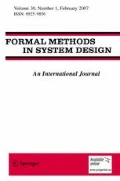Abstract
We describe a method for computing a minimum-state automaton to act as an intermediate assertion in assume-guarantee reasoning, using a sampling approach and a Boolean satisfiability solver. For a set of synthetic benchmarks intended to mimic common situations in hardware verification, this is shown to be significantly more effective than earlier approximate methods based on Angluin’s L* algorithm. For many of these benchmarks, this method also outperforms BDD-based model checking and interpolation-based model checking. We also demonstrate how domain knowledge can be incorporated into our algorithm to improve its performance.
Similar content being viewed by others
References
Alur R, Madhusudan P, Nam W (2005) Symbolic compositional verification by learning assumptions. In: Proceedings of the international conference on computer aided verification (CAV), pp 548–562
Angluin D (1987) Learning regular sets from queries and counterexamples. Inf Comput 75:87–106
Biere A, Cimatti A, Clarke E, Zhu Y (1999) Symbolic model checking without BDDs. In: Tools and algorithms for the construction and analysis of systems (TACAS’99), LNCS
Cobleigh J, Giannakopoulou D, Pasareanu C (2003) Learning assumptions for compositional verification. In: Proceedings of the 9th international conference on tools and algorithms for the construction and analysis of systems (TACAS)
Chaki S, Strichman O (2007) Optimized l*-based assume-guarantee reasoning. In: TACAS, pp 276–291
Gold EM (1978) Complexity of automaton identification from given data. Inf Comput 37:302–320
Kam T, Villa T, Brayton R, Sangiovanni-Vincentelli AL (1997) Synthesis of FSMs: functional optimization. Kluwer Academic, Dordrecht
McMillan KL Cadence SMV. Cadence Berkeley Labs, CA
McMillan KL (1993) Symbolic model checking. Kluwer Academic, Boston
Mitchell TM (1997) Machine learning. WCB/McGraw-Hill, New York
Oliveira AL, Marques Silva JP (1998) Efficient search techniques for the inference of minimum size finite automata. In: Proceedings of the symposium on string processing and information retrieval (SPIRE), pp 81–89
Pena JM, Oliveira AL (1999) A new algorithm for exact reduction of incompletely specified finite state machines. IEEE Trans CAD Integr Circuits Syst 18(11):1619–1632
Pfleeger CF (1973) State reduction in incompletely specified finite state machines. IEEE Trans Comput C-22:1099–1102
Quinlan JR (1986) Induction of decision trees. Mach Learn
Rivest RL, Schapire RE (1989) Inference of finite automata using homing sequences. In: Proceedings of the ACM symposium on theory of computing (STOC). ACM Press, New York, pp 411–420
Sinha N, Clarke EM (2007) Sat-based compositional verification using lazy learning. In: CAV, pp 39–54
Author information
Authors and Affiliations
Corresponding author
Rights and permissions
About this article
Cite this article
Gupta, A., McMillan, K.L. & Fu, Z. Automated assumption generation for compositional verification. Form Methods Syst Des 32, 285–301 (2008). https://doi.org/10.1007/s10703-008-0050-0
Published:
Issue Date:
DOI: https://doi.org/10.1007/s10703-008-0050-0




